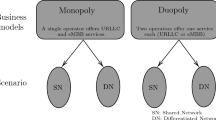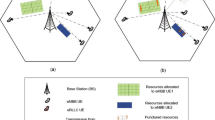Abstract
A multilink (ML) methodology efficiently combines unicast (UC) and multicast (MC) transmissions to provide service to numerous devices. In this paper, the appropriate use of ML solutions for UC/MC transitions in 5G core networks is presented and discussed. Using system-level simulation, the reliability of ML, MC and UC transmission in 5G core networks are investigated and discussed under different scenarios and environments. Firstly, when the threshold of ML switching is great (e.g., 10 dB), Modeling findings indicate that for the majority of user equipment (UE) density levels, ML consumes more resources than UC. This is due to the fact that ML employs extra PTP (Point-to-Point) connections. Secondly, if the UE density is more than 20 UEs/cell and the threshold is low (e.g., 5 dB), resource usage with ML will be lower than with UC since fewer UEs are using extra PTP lines. As a result, In the case of ML, expanding the UE density increases the number of PTP links, resulting in increased resource consumption and reduced Average layer spectral efficiency (AL-SE). When the UE density increases due to the MCS index limit and ML switching threshold, ML follows the same QoE evolution as UC with a worse Mean Opinion Score (MOS) score. Thirdly, Lowering of the ML switching threshold causes a reduction in the number of UEs with excellent service reception as more UEs have to rely on pure MC. Although still insufficient for the UE density of 20 UEs/cell or more, the active network resources can better handle the UEs because there are fewer duplicate PTP lines. If the density is equal to 10 UEs/cell and the threshold of ML switching is equal to 5 dB, when compared to UC, ML achieves ideal QoS for roughly 70% of the UEs, where more than 90% of the coverage is obtained. However, ML achieves an AL-SE that is nearly 50% greater than that in UC. The obtained results indicate that the MC delivery mode can be used as a network resource usage optimization for the distribution of general data. Moreover, through the use of ML technology, the trade-off in the reliability in service delivery and user experience by switching from UC to MC is improved. Hence, the ML is considered to be beneficial for intermediate UE density in the cell. For example, by using ML for most UEs, the reliability of the service delivery can be restored, and spectral efficiency is significantly improved compared to that using UC. To cover larger populations, different ML algorithms that are not as much resource demanding could be used. Therefore, lower threshold of ML switching and a greater modulation and coding scheme (MCS) index may be selected to bring more benefits to ML in terms of resource consumption.










Similar content being viewed by others
Data Availability
The datasets generated during and/or analysed during the current study are available from the corresponding author on reasonable request.
Data Availability
Not applicable.
Code Availability
Not applicable.
References
Ericsson Mobility Report (December 2021). Available online: https://www.ericsson.com/en/reports-and-papers/mobility-report/reports/november-2021 (accessed on 1 December 2021)
Garro, E., et al. (June 2020). “5G Mixed Mode: NR Multicast-Broadcast Services,“ in IEEE Transactions on Broadcasting, vol. 66, no. 2, pp. 390–403, https://doi.org/10.1109/TBC.2020.2977538
Condoluci, M., Johnson, S. H., Ayadurai, V., Lema, M. A., Cuevas, M. A., Dohler, M., & Mahmoodi, T. (2019). Fixed-mobile convergence in the 5G era: From hybrid access to converged core. IEEE Network, 33(2), 138–145
Zhang, L., Wu, Y., Li, W., Salehian, K., Lafleche, S., Wang, X., … Montalban, J. (2018). Layered-division multiplexing: An enabling technology for multicast/broadcast service delivery in 5G. IEEE Communications Magazine, 56(3), 82–90
Anchan, K. (2016). “Evolved multimedia broadcast/multicast services (eMBMS) geo-location based group call.“ U.S.Patent No.9,294,886. 22 Mar.
Chih-Lin, I., Han, S., Xu, Z., Sun, Q., & Pan, Z. (2016). 5G: Rethink mobile communications for 2020+. Phil Trans R Soc A, 374, 1–13. https://doi.org/10.1098/rsta.2014.0432
Singhal, C., & De, S. (2018). UE-TV: User-centric energy-efficient HDTV broadcast over LTE and Wi-Fi. IEEE Transactions on Mobile Computing, 18(7), 1703–1717
Liu, G., & Jiang, D. (2016). 5G: Vision and Requirements for Mobile Communication System towards Year 2020. Chinese Journal of Engineering, 2016, 1–8. https://doi.org/10.1155/2016/5974586
Chengab, J., Chena, W., Tao, F., & Lin, C. L. (2018). Industrial IoT in 5G environment towards smart manufacturing. Journal of Industrial Information Integration, 10, 10–19. https://doi.org/10.1016/j.jii.2018.04.001
Atakora, M., & Chenji, H. (2018). A Multicast Technique for Fixed and Mobile Optical Wireless Backhaul in 5G Networks. Ieee Access : Practical Innovations, Open Solutions, 6, 27491–27506. https://doi.org/10.1109/ACCESS.2018.2832980
Kim, H. (2020). Design and optimization for 5 g wireless communications. John Wiley & Sons
5G-Xcast WP4 D4.1 (“Mobile Core Network,” 2018). Available online: https://5 g-xcast.eu/2018/06/01/deliverable-d4-1-on-mobile-core-networks-available/ (accessed on 1 January 2020)
3GPP TS (January 2021). 26.346 version 12.3.0 Release 12. “Multimedia Broadcast/Multicast Service (MBMS); Protocols and codecs,” Available online: https://www.etsi.org/deliver/etsi_ts/126300_126399/126346/12.03.00_60/ts_126346v120300p.pdf (accessed on 10 January 2021)
5G-Xcast project (January 2021). Available online: https://5g-ppp.eu/5 g-xcast/ (accessed on 1 January 2021)
5G TODAY research project, Available online: https://www.irt.de/en/research/radio-systems/5 g-today, (accessed on 20 February 2021)
Montalban, J., et al. (2018). Multimedia Multicast Services in 5G Networks: Subgrouping and Non-Orthogonal Multiple Access Techniques. IEEE Communications Magazine, 56 no(3), 91–95. https://doi.org/10.1109/MCOM.2018.1700660
Yang, J., Luo, J., Wang, J., & Guo, S. (2019). Cooperative Multicast and Unicast with Viewport Prediction for VR Video Streaming in 5G H-CRAN. Ieee Access : Practical Innovations, Open Solutions, 7, 134187–134197. https://doi.org/10.1109/ACCESS.2019.2941646
Ali, F., He, Y., Shi, G., Sui, Y., & Yuang, H. (2020). Future Generation Spectrum Standardization for 5G and Internet of Things. J Commun, 15(3), 276–282
Liu, G., Wang, Z., Hu, J., Ding, Z., & Fan, P. (2019). “Cooperative NOMA Broadcasting/Multicasting for Low-Latency and High-Reliability 5G Cellular V2X Communications,“ in IEEE Internet of Things Journal, vol. 6, no. 5, pp. 7828–7838, Oct. https://doi.org/10.1109/JIOT.2019.2908415
Samuylov, A., Beschastnyi, V., Moltchanov, D., Ostrikova, D., Gaidamaka, Y., & Shorgin, V. (2019). Modeling Coexistence of Unicast and Multicast Communications in 5G New Radio Systems. 2019 IEEE 30th Annual International Symposium on Personal, Indoor and Mobile Radio Communications (PIMRC), Istanbul, Turkey, pp. 1–6. https://doi.org/10.1109/PIMRC.2019.8904350
Zhang, L., et al. (2016). Improving LTE ${e} $ MBMS With Extended OFDM Parameters and Layered-Division-Multiplexing. IEEE Transactions on Broadcasting, 63(1), 32–47
3GPP (2019). TS 38.413 version 15.3.0 Release 15, “5G; NG-RAN; NG Application Protocol (NGAP),” Available online: https://www.etsi.org/deliver/etsi_ts/138400_138499/138413/15.03.00_60/ts_138413v150300p.pdf, (accessed on 15 February 2021)
Odarchenko, R., Altman, B., Aguiar, R., & Sulema, Y. (2018). Multilink Approach for the Content Delivery in 5G Networks. Proceedings of the 5th International Scientific-Practical Conference on the Problems of Infocommunications. Science and Technology (PIC S&T), Kharkiv, Ukraine, October 9–12, pp. 140–144
5G-Xcast WP4 D4.3 (December 2018). “Session control and management,” Available online: https://5 g-xcast.eu/2018/12/04/deliverable-d4-3-on-session-control-and-management-available/, (accessed on 10 January 2021)
Aijaz, A. (2019). Packet duplication in dual connectivity enabled 5G wireless networks: overview and challenges. IEEE Communications Standards Magazine, 3(3), 20–28
RP-152213: “Revised WID: LTE-WLAN Radio Level Integration and Interworking Enhancement,” Intel, 3GPP RAN Plenary #70, Sitges, Spain,
Abinader, F. M., de Sousa, V. A., Choudhury, S., et al. (2018). LTE/Wi-Fi Coexistence in 5 GHz ISM Spectrum: Issues, Solutions and Perspectives. Wireless Personal Communications, 99, 403–430. https://doi.org/10.1007/s11277-017-5114-2
3GPP TS 36 (3.360 version 13.0.0 Release 13, “LTE, Evolved Universal Terrestrial Radio Access (E-UTRA), LTE-WLAN Aggregation Adaptation Protocol (LWAAP) Specification,” 2016). Available online: https://www.etsi.org/deliver/etsi_ts/136300_136399/136360/13.00.00_60/ts_136360v130000p.pdf, (accessed on 10 January 2020)
Odarchenko, R., Gimenez, J., Sulema, Y., Altman, B., & Petersen, S. (2019). Multilink Solution for 5G: Efficiency Experimental Studies. 2019 3rd International Conference on Advanced Information and Communications Technologies (AICT), Lviv, Ukraine, pp. 336–339. https://doi.org/10.1109/AIACT.2019.8847862
3GPP (2017). TR 38.901 version 14.0.0 Release 14, “5G, Study on channel model for frequencies from 0.5 to 100 GHz,” Sophia Antipolis, France, Tech. Rep. Available online: https://www.etsi.org/deliver/etsi_tr/138900_138999/138901/14.00.00_60/tr_138901v140000p.pdf
ITU-R. Report ITU-R M.2412-0 (10/2017); Guidelines for evaluation of radio interface technologies for IMT-2020.ITU, Geneva, Switzerland. Available online: https://www.itu.int/dms_pub/itu-r/opb/rep/R-REP-M.2412-2017-PDF-E.pdf
ISO/IEC. Information technology – Dynamic adaptive streaming over HTTP (DASH) – Part 1: Media presentation description and segment formats. Doc. ISO/IEC 23009-1:2014, 2nd Edition, International Organization for Standardization/International Electrotechnical Commision, Geneva, Switzerland. Available online: https://www.iso.org/standard/65274.html
Standard, A. T. S. C. (2017). “Signaling, Delivery, Synchronization, and Error Protection,” Available online: https://www.atsc.org/wp-content/uploads/2017/12/A331-2017-Signaling-Deivery-Sync-FEC-3.pdf
Liu, C., Bouazizi, I., & Gabbouj, M. (2011). Rate Adaptation for Adaptive HTTP Streaming. MMSys ‘11 Proceedings of the second annual ACM conference on Multimedia systems, pp. 169–174
System Level Simulation – RealNeS. Available online: http://nomor.de/services/simulation/system-level-simulation/
ITU-R. Draft new report ITU-R M.[IMT-2020.EVAL]: Guidelines for evaluation of radio interface technologies for IMT-2020 (2017).
Funding
Not applicable.
Author information
Authors and Affiliations
Corresponding author
Ethics declarations
Conflicts of interest/Competing interests
Not applicable.
Additional information
Publisher’s Note
Springer Nature remains neutral with regard to jurisdictional claims in published maps and institutional affiliations.
Rights and permissions
About this article
Cite this article
Al-Azzeh, J.S., Al-Qaisi, A., Odarchenko, R. et al. Multilink Solution for Seamless Transition Between Multicast and Unicast Areas in 5G Core Network. Wireless Pers Commun 126, 2701–2718 (2022). https://doi.org/10.1007/s11277-022-09837-1
Received:
Revised:
Accepted:
Published:
Issue Date:
DOI: https://doi.org/10.1007/s11277-022-09837-1




